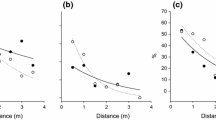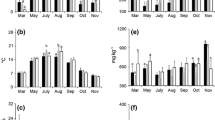Abstract
Measured carbon dioxide (CO2) flux from peat soils using the closed chamber technique combines root-related (autotrophic + heterotrophic where rhizosphere organisms are involved) and peat-based (heterotrophic) respiration. The latter contributes to peat loss while the former is linked to recent CO2 removal through photosynthesis. The objective of this study was to separate root- from peat-based respiration. The study was conducted on peatland under 6 and 15 year old oil palm (Elaeis guineensis Jacq.) plantations in Jambi Province, Indonesia in 2011 to 2012. CO2 emissions were measured in the field from 25 cm diameter and 25 cm tall closed chambers using an infrared gas analyser. Root sampling and CO2 emissions measurements were at distances of 1.0, 1.5, 2.0, 2.5, 3.0, 3.5, 4.0, and 4.5 m from the centre of the base of the palm tree. The emission rate for the six and 15 year old oil palm plantations at ≥3.0 m from the centre of the tree were 38.2 ± 9.5 and 34.1 ± 15.9 Mg CO2 ha−1 yr−1, respectively. At distances <2.5 m, total respiration linearly decreased with distances from the trees. Heterotrophic respirations were 86 % of the 44.7 ± 11.2 and 71 % of 47.8 ± 21.3 Mg CO2 ha−1 yr−1 of weighted surface flux, respectively for the 6 and 15 year old plantations. We propose that CO2 flux measurements in oil palm plantations made at a distance of ≥3 m from the tree centre be used to represent the heterotrophic respiration that is relevant for the environmental impact assessment.







Similar content being viewed by others
References
Agus F, Handayani E, van Noordwijk M et al. (2010) Root respiration interferes with peat CO2 emission measurement. 19th World Congress of Soil Science, Brisbane, 1–6 August 2010
Agus F, Mulyani A, Wahyunto et al (2011) Accountability and local level initiative to reduce emission from deforestation and degradation in Indonesia (ALLREDDI): Gap filling and capacity building of peat soil characteristics. Centre for Agricultural Land Resources Research and Development (ICALRD) and World Agroforestry Centre (ICRAF), Bogor
Agus F, Mulyani A, Dariah A et al. (2012) Peat maturity and thickness for carbon stock estimation. Proceedings, 14th International Peat Congress, Stockholm, 3–8 June 2012
Blockwell J, Searle SD, Jeavon AC et al (2005) Nitrogen Fixation in acasias: an untapped resource for sustainable plantations, farm forestry and land reclamation, CSIRO. Australian Centre for International Research. p:132
Chan KW (1977) A rapid method for studying the root distribution of Oil palm and its application. In: Earf DA, Newall W (eds) International development in oil palm. Incorporated Society of Planters, Kuala Lumpur, pp 131–151
Eiland F, Klamer M, Lind AM et al (2001) Influence of intial C/N ratio on chemical and microbial composition during long term composting of straw. Microb Ecol 41(3):272–280
Evett SR (ed) (2007) Irrigation of agricultural crops. Agronomy monograph No. 30, 2nd edn. American Society of Agronomy, Wisconsin
Fargione J, Hill J, Tilman D et al (2008) Land clearing and the biofuel carbon debt. Science 319:1235–1238
Freeman C, Ostle N, Kang H (2001) An Enzymic ‘latch’ on global carbon store-a shortage of oxygen locks up carbon in peatlands by restraining a single enzyme. Nature 409:149
Galiana A, Gnahoua GM, Chaumont J et al (1998) Improvement of Nitrogen Fixation in Acasia Mangium through Inoculation with Rhizobium. Agrofor Syst 40:297–307
Gardner WH (1986) Water content. In: Klute A (ed) Methods of soil analysis, part 1, physical and mineralogical methods, 2nd edn. Agronomy 9, American Society of Agronomy, Wisconsin, pp 493–544
Hanson PJ, Edwards NT, Garten CT et al (2000) Separating root and soil microbial contributions to soil respiration: a review of methods and observations. Biogeochemistry 48:115–146
Hartley CWS (1977) The oil palm. 2nd edn. Tropical agriculture series. Longman. London and New York. p: 806
Henson IE, Chai SH (1997) Analysis of oil palm productivity. II. Biomass, distribution, productivity and turnover of the root system. Elaeis 9(2):78–92
Hergoualc’h K, Verchot LV (2011) Stocks and fluxes of carbon associated with land use change in Southeast Asian tropical peatlands: A review. Glob Biogeochem Cycles 25:1–13. doi:10.1029/2009GB003718
Hooijer A, Page S, Jauhiainen J et al (2012) Subsidence and carbon loss in drained tropical peatlands. Biogeosciences 9:1053–1071. doi:10.5194/bg-9-1053-2012
ICALRD (Indonesian Centre for Agricultural Land Resources Research and Development) (2011) Penelitian dan pengembangan teknologi pengelolaan lahan gambut berkelanjutan untuk meningkatkan sequestrasi karbon dan mitigasi gas rumah kaca. Indonesia Climate Change Trust Fund (ICCTF). Badan Litbang Pertanian, Bogor
Jauhiainen J, Heikkinen J, Martikainen PJ et al (2001) CO2 and CH4 fluxes in pristine and peatland converted to agriculture in Central Kalimantan, Indonesia. Int Peat J 11:43–49
Jauhiainen J, Hooijer A, Page SE (2012) Carbon dioxide emissions from an Acacia plantation on peatland in Sumatra, Indonesia. Biogeosciences 9:617–630. doi:10.5194/bg-9-617-2012
Jourdan C, Rey H (1997) Architecture and development of the oil palm (Elaeis guineensis Jacq.) root system. Plant Soil 189:33–48
Jourdan C, Ferriere NM, Perbals G (2000) Root system architecture and gravitropism in the oil palm. Ann Bot 85:861–868. doi:10.1006/anbo
Kelting DL, Burger JA, Edwards GS (1998) Estimating root respiration, microbial respiration in the rhizosphere, and root-free soil respiration in forest soils. Soil Biol Biochem 30(7):961–968
Khalid H, Zin ZZ, Anderson JM (1999) Quantification of oil palm biomass and nutrient value in mature planttation. II Below-ground biomass. J Oil Palm Res 11(2):63–71
Knorr KH, Oosterwoud MR, Blodau C (2008) Experimental drought alters rates of soil respiration and methanogenesis but not carbon exchange in soil of a temperate fen. Soil Biol Biochem 40:1781–1791
Kuzyakov Y, Cheng W (2001) Photosynthesis controls of rhizosphere respiration and organic matter decomposition. Soil Biol Biochem 33(14):1915–1925
Law BE, Kelliher FM, Baldocchi DD et al (2001) Spatial and temporal variation in respiration in a young ponderosa pine forest during a summer drought. Agric For Meteorol 110:27–43
Madsen R, Xu L, Claassen B et al (2009) Surface monitoring method for carbon capture and storage projects. Energy Proc 1:2161–2168
Marchante E, Kjoller A, Struwe S et al (2008) Short-and long term impact of Acasia longofolia invasion on the belowground processes of a mediterranean coastal dune ecosystem. Soil Ecol 40(2):210–217
Martoyo K (1992) Kajian Sifat Fisik Tanah Podsolik untuk Tanaman Kelapa Sawit (Elaeis guineensis Jacq.) di Sumatera Utara. MS Thesis, Gajah Mada University, Yogyakarta
Melling L, Hatano R, Goh KJ (2005) Soil CO2 flux from three ecosystems in tropical peatland of Sarawak, Malaysia. Tellus 57:1–11
Melling L, Hatano R, Goh KJ (2007) Nitrous oxide emissions from three ecosystems in tropical peatland of Sarawak, Malaysia. Soil Sci Plant Nutr 53:792–805
Minkinnen K, Laine J, Shurpali NJ et al (2007) Heterotropic soil respiration in forestry-drained peatland. Boreal Environ Res 12:115–126
MoE (Ministry of Environment, Republic of Indonesia) (2010) Indonesian Second National Communication under the United Nations Framework Convention on Climate Change (UNFCCC). MoE, Jakarta
Murayama S, Bakar ZA (1996) Decomposition of Tropical Peat Soils. Jpn Agric Res Q 30:153–158
Murdiyarso D, Hergualc’h K, Verchot LV (2010) Opportunities for reducing green house gas emission in tropical peatlands. PNAS 107(46):19655–19660
Page S, Morrison ER, Malins C, Hooijer A, Rieley JO and Jauhiainen J (2011) Review of peat surface greenhouse gas emissions from oil palm plantations in Southeast Asia. International Council on Clean Transportation
Pregitzer KS, Laskowski MJ, Burton AJ et al (1997) Variation in sugar maple root respiration with root diameter and soil depth. Tree Physiol 18:665–670
Reijnders L, Huijbregts MAJ (2008) Palm oil and the emission of carbon-based greenhouse gases. J Clean Prod 16:477–482
Schroth G, Rodrigues MRL, D’Angelo SA (2006) Spatial patern of nitrogen mineralization, fertilizers distribution and root explain nitrate leaching from mature amazonian oil palm plantation. Soil Use Manag 16:222–229. doi:10.1111/j.1475-2743.2000.tb000197x
Tinker PB (1976) Soil requirement of the oil palm. In: Corley RHV, Hardon JJ, Wood BJ (eds). Oil Palm Research. Elsevier Scientific Publishing Company, p. 165–181
Van Noordwijk M, Floris J, De Jager A (1985) Sampling schemes for estimating root density distribution in cropped fields. Neth J Agric Sci 33:241–262
Wang W, Ohseb K, Liuc J et al (2005) Contribution of root respiration to soil respiration in a C3/C4 mixed grassland. J Biosci 30(4):507–514
Wicke B, Dornburg V, Junginger M et al (2008) Different palm oil production systems for energy purposes and their greenhouse gas implications. Biomass Bioenergy 32:1322–1337
Wösten JHM, Ismail AB, Van Wijk ALM (1997) Peat subsidance and its practical implication: a case in Malaysia. Geoderma 78:25–36
Wösten JHM, Clymans E, Page SE, Rieley JO, Limin SH (2008) Peat-water interrelationship in tropical peatland ecosystem in Southeast Asia. Catena 72:212–224
Acknowledgments
This research was funded by the European Community’s Seventh Framework Programme (FP7-ENV-2008-1), Project Number No. 226310 (REDD-ALERT). We thank Dr. Meine van Noordwijk from the World Agroforestry Centre and Ms. Jenny Farmer from Aberdeen University for their advise on this manuscript. We thank Dr. Endrizal, the head of and his staff of the Assessment Institute of Agricultural Technology, in Jambi, Indonesia for facilitation and assistance in field work.
Author information
Authors and Affiliations
Corresponding author
Rights and permissions
About this article
Cite this article
Dariah, A., Marwanto, S. & Agus, F. Root- and peat-based CO2 emissions from oil palm plantations. Mitig Adapt Strateg Glob Change 19, 831–843 (2014). https://doi.org/10.1007/s11027-013-9515-6
Received:
Accepted:
Published:
Issue Date:
DOI: https://doi.org/10.1007/s11027-013-9515-6




